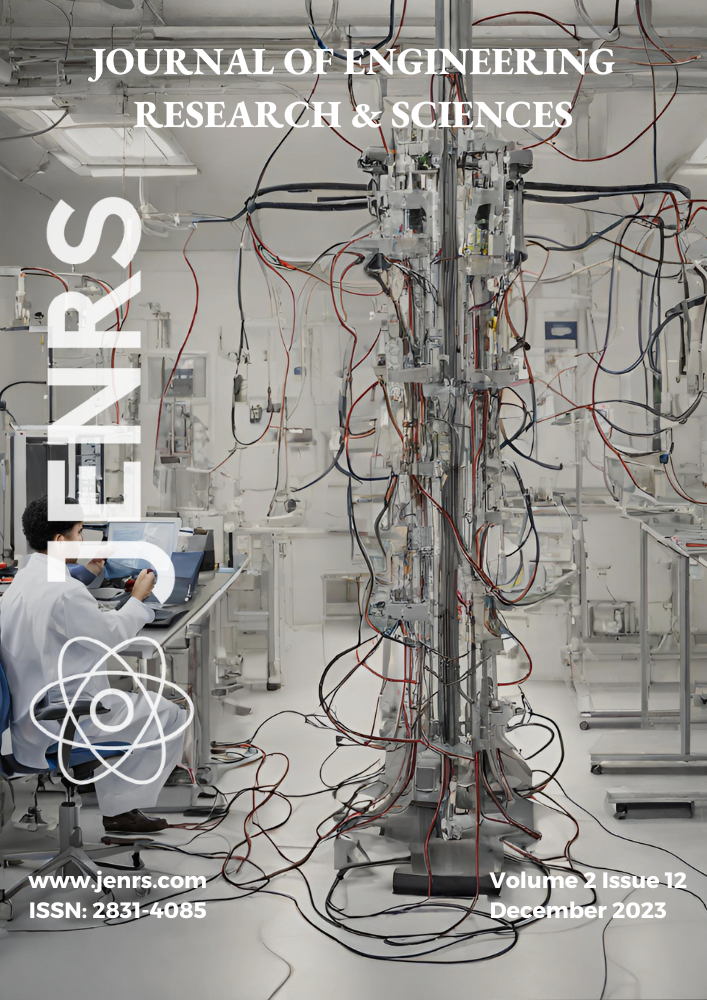
Publication Month: January 2022, Page(s): A1 – A1
Publication Month: January 2022, Page(s): B1 – B1
Publication Month: January 2022, Page(s): C1 – C1
Publication Month: January 2022, Page(s): D1 – D1
Hua Younan, Liao Jinzhi Lois, Liu Binghai, Zhu Lei, Li Xiaomin
J. Engg. Res. & Sci. 2(12), 1-6 (2023);
In semiconductor wafer fabrication, the contamination issue by halogens (such as F, Cl, and Br) brings great challenges to metallization processes in the back end of line (BEOL). For aluminum (Al) back-end process, severe metal corrosion may occur by halogens, forming aluminum halide defects. Such halogen-induced metal corrosion issue creates the defects on Al metal lines, Al bondpads and Vias, causing direct device failure, resulting in low yield and reliability issue. In this paper, we reported failure analysis and mechanism studies of the Worm-like defects in Via holes, which was caused by Cl contamination and the subsequent Al metal corrosion. With this study, a corrosion mechanism was proposed in which a Cl-based chemical chain-reaction resulted in repeated/continuously enhanced chemical corrosion even with a small amount of Cl ions. The chemical chain-reactions caused more serious corrosion with corrosive by-products. Such Cl-induced Al metal corrosion and the worm-like defect formation resulted in the process integrity issues related to Al metallization processes, such as voiding in Via structures, opening or bridging in between metal lines.
Anam Javaid, Sumaira Aslam, Hira Qaisar, Farhat Batool, Rimsha Javed, Muhammad Waqas Qaisar
J. Engg. Res. & Sci. 2(12), 7-14 (2023);
Plastics are routinely used in the packaging of materials as well as in industrial production. However, once in the environment, they are non-biodegradable, posing severe threats to the ecosystems. Bioplastic replaces conventional plastic, which is biodegradable due to its biological origin and does not affect environment. Sawdust is a very important agro-waste screened as a substrate for bioplastic production. In the present study, bacteria capable of producing bioplastic by utilizing sawdust as a cheap substrate were isolated and optimized for bioplastic production. Eight sawdust utilizing bacteria were isolated and the strains were designated as SD1 to SD8. These indigenous bacterial isolates were screened for bioplastic production using Sudan Black B Staining. Among the bacterial isolates, the bioplastics (PHB) production levels were 0.046 g/mL to 0.32 g/mL, while the maximum PHB (g/ml) production (0.32 ± 0.008g/mL) was given by SD2 isolate identified as the Bacillus cereus-SD2 strain through 16SrDNA sequencing. The isolate SD2 was optimized for bioplastic production at different growth conditions. The best temperature for the bioplastic production was 37˚C in the saw dust containing low-cost medium and yielded 0.32 ± 0.00 optical density at wavelength 235 nm of crotonic acid. The isolate SD2 showed a higher PHB (g/ml) yield of 0.31 ± 0.008 under alkaline conditions of pH 9. Sufficient oxygen was required for the higher PHB (g/ml) production by the bacterial isolate SD2, which yielded a 0.32 ± 0.006 level of PHB as compared to the non-aeration. The Bacillus cereus-SD2 is a promising bacterial which can produce environmentally friendly bioplastics using low-cost substrate. Finding more growth condition for enhanced bioplastics yields in future are suggested to scale up the production process at industrial level.
Neha Koppikar, Nidhi Koppikar
J. Engg. Res. & Sci. 2(12), 15-22 (2023);
Since 2020, people have been getting their body temperatures checked at every public location, social distancing has become a norm, and it has become essential to know who has been in contact with whom. Therefore, we needed a system that helped us solve these challenges, especially in housing societies, as most of the general public stayed home more than ever. Therefore, it has become essential to safeguard housing societies. There has been a lot of research in building a security system, but there needs to be more research that targets housing societies as the end users. We have devised a possible solution, including a facial recognition system with body temperature sensing on a Raspberry Pi. The best part of our application is the automated data collection page on aweb application, which makes collecting facial images more straightforward and faster. Code for this project can be found at: https://github.com/NehaKoppikar/Monitoring-System-for-Housing-Societies-using-Deep-Learning-and-IoT
Yi Liu, Wendy Wang, Haibo Wang, Bahram Alidaee
J. Engg. Res. & Sci. 2(12), 23-33 (2023);
Information extracted from remote sensing data can be applied to monitor the business and natural environments of a geographic area. Although a wide range of classical machine learning techniques have been utilized to obtain such information, their performance differs greatly in classification accuracy. In this study, we aim to examine whether quantum-enhanced machine learning can improve the performance of classical machine learning algorithms in binary classifications of satellite remote sensing data. Using 16 pre-labeled datasets, we apply Support Vector Machine-quantum annealing solver (SVM-QA) – a type of quantum machine learning algorithm, with optimized (Gamma) value on the task of image classification and compare its results with the top performers of classical machine learning algorithms. The results show that in 10 out of 16 datasets, the hyper parameterized SVM-QA classifier outperforms the best classical machine learning algorithms in terms of classification accuracy. The findings suggest the potentiality of quantum computing in remote sensing. This study contributes to the literature of remote sensing image data classification and applications of quantum machine learning for problem solving.
This sidebar is currently being updated and may temporarily overlap with the pages.

This work is licensed under a Creative Commons Attribution-ShareAlike 4.0 International License.